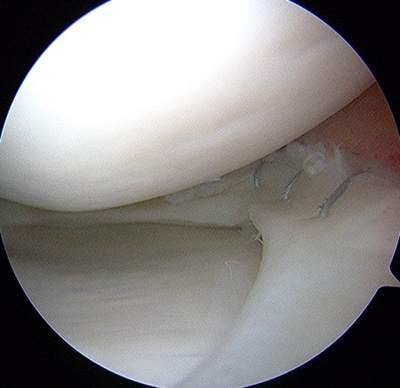Meniscus surgery is required for meniscus tears that continue to cause pain, disability, or limit motion. Treatment of meniscus problems may also be performed at the same time as other knee operations, such as ACL reconstruction.
Meniscus surgery is often performed as a day surgery procedure, and usually only requires two small holes in the front of the knee. The surgery is performed using arthroscopic "keyhole" techniques. Most patients are able to walk immediately, and may only require crutches for comfort for the first week. The majority of patients recover most of their knee function in 2 to 4 months.

While it is preferable to try to repair meniscus tears, so as to preserve the normal cushioning function of the meniscus - repair is not always possible. This is because only the outer 1/3 of the meniscus has a blood supply. The inner 2/3 of the meniscus relies on nutrition from the joint's normal fluids. As such, only tears involving the outer 1/3 of the meniscus have a good chance of healing after repair. The picture below shows a successful repair of an outer one third or "peripheral" meniscus tear.
Inner 2/3 meniscus tears are unlikely to heal after repair, because of their lack of blood supply. In any case, these tears are more difficult to stitch together because that part of the meniscus is quite thin and flimsy anyway. Often the treatment would be to trim off the torn meniscus, leaving a stable rim, which will not flip around and continue to cause pain.
While some surgeons in Europe and the USA are experimenting with artificial "meniscus replacements" to replace the cushioning function of the meniscii, to this date, these "implants" have not been proven to offer significant benefits. As such, these "meniscal implants" have not been adopted as mainstream treatments as yet.
A small group of young patients who have lost a large part of their meniscii due to severe injury, or irreparable meniscus tears, may develop pain in the knee due to the increased pressures from the loss of cushioning. In this very selected group of patients, meniscus transplantation may be required. This involves using a human meniscus taken from a donor, which is appropriately cleaned and prepared to prevent transmission of infection or disease. The surgery is still performed with the assistance of arthroscopy. Often crutches and a knee brace are required for 2-3 months, and it may take up to a year before the patient returns to normal.
